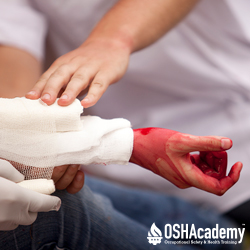Emergency Procedures
Knowing how to respond in an emergency, particularly when dealing with lacerations or cuts from utility knives, is crucial in the workplace.
Selecting and using the right Personal Protective Equipment (PPE) is a key part of staying safe when using utility knives.
First-Aid for Lacerations and Cuts
- Ensure Safety and Assess the Injury: Before providing first aid, make sure the environment is safe. Secure any hazards, including the utility knife that caused the injury. Assess the severity of the cut or laceration.
- Equipment and PPE: Retrieve a first-aid kit and put on personal protective equipment (PPE), such as gloves.
- Clean the Wound: Rinse the wound thoroughly with cool running water to remove any dirt or debris. Use mild soap around the area, but not directly in the wound to avoid irritation. Avoid using hydrogen peroxide or iodine, as these can irritate the wound.
- Control Bleeding: Apply gentle pressure with a sterile bandage or a clean cloth. If the bleeding is severe and does not slow down, continue to apply pressure, and seek medical help immediately.
- Cover the Wound: Once the bleeding is under control, apply a sterile adhesive bandage or sterile dressing to the wound. This helps prevent infection and aids in the healing process.
- Seek Medical Attention: If the cut is deep or won't stop bleeding, seek professional medical care.
Knowledge Check Choose the best answer for the question.
6-1. How should you stop the bleeding from a cut caused by a utility knife?
You forgot to answer the question!

